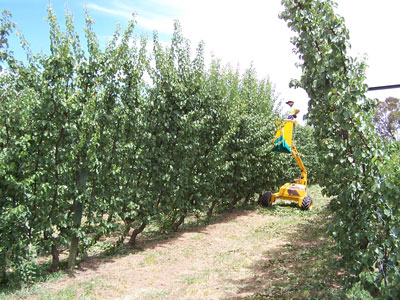The success of your orchard investment is determined in Year One!
• Establish windbreaks or shelterbelts if necessary, before you plant your orchard.
• Make sure that natural shelterbelts (trees) will not interfere with the growth and cropping of your fruit trees.
• Have the soil of your new orchard analysed and recommendations made by a reputable and unbiased laboratory.
• Prepare the soil in autumn. This may include fumigation.
A good soil is the foundation upon which the performance of your trees is built. Take your time and plan the preparation of your soil well.
• Ask your nurseryman:
-To harden off your trees properly (mature the wood).
-To keep as many roots as possible on the trees.
-Not to head the leaders.
-Not to damage the feathers and buds.
• Install a low-flow irrigation system with facilities to fertigate.
• If you intend to plant the trees by hand, erect the complete trellis before you plant the trees.
If you are going to plant your trees mechanically, you must make sure that the trellis will be erected soon after the trees have been planted.
• Arrange for a proper pattern of suitable polliniser trees, and order and plant these at the same time as you order the main variety.
• Plant the trees in rows that run preferably north–south.
• When you receive the trees from the nursery, never allow the roots to dry out.
Store the trees in bins with moist sawdust or in a well-drained cool spot in your orchard.
Never store trees near fruit.
Only cut off pieces of root that have been broken.
• If necessary, grade your trees according to size.
Plant the trees of each size in a separate row to facilitate their management.
• Handle trees very gently. Trees on dwarfing rootstocks can easily break off at the graft-union if handled roughly.
• Plant the trees early so that the roots can start to grow and support the young leaves and shoots in spring.
• Supervise the planting operation strictly. A sloppy job can cause trees to perform poorly throughout the life of the orchard.
• Plant the trees shallow if the rootstock is semi-vigorous and the soil is strong.
Water the trees in to ensure that the roots are in good contact with soil. Tree roots can dry out even though the soil is moist.
• Apply a pre-emergent herbicide and secure the trees to the trellis wires.
Carefully follow the instructions on how to apply the herbicide. Weeds and wind are the trees’ biggest enemies.
• Do not over-water the trees.
The trees require short, frequent waterings when the leaves appear in spring and the soil starts to dry out.
• Control weeds right from the start. Weeds compete with trees for water and nutrients, and can retard the growth of newly-planted trees.
Trees can grow more than twice the size when weeds are controlled than do trees with weeds.
• Apply small amounts of fertiliser when the new shoots are about 150 mm long.
• Watch out for pests, diseases, hares, rodents, crickets, birds etc. which are ever ready to spoil your investment.
• A layer of straw around each tree can be beneficial but can harbour crickets and field mice, and keep the soil too wet if water content of the soil is not monitored properly.
• Train more—prune less.
This article is reproduced with permission from the Orchard Manual:
Apple on Open Tatura
by Bas van den Ende
See this article in Tree Fruit August 2021






















